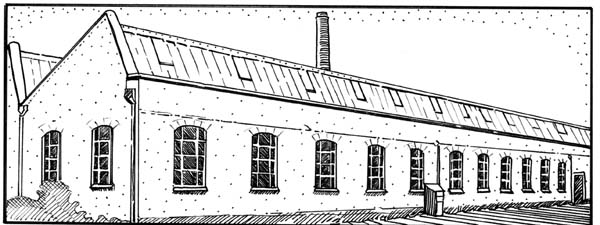Mount Mills
Situation
A mile downstream from Bridge Street Mill in Witney, it was
built on a 14-acre site known as Mount Farm. It was located next
to the railway goods station so was conveniently placed for
receiving in raw materials and sending out finished goods.
Physical structure
Built by James Marriott in 1897-1900 to designs by J. Kirk and
Sons of Dewsbury. It was designed as a fully integrated modern
factory which combined and catered for all stages of blanket
production on one site. This was in contrast to many of the
earlier mills in Witney which had developed from fulling or
water-powered spinning establishments and where the weaving and
finishing processes tended to be fitted around these original
activities.
 Drawing of the weaving sheds at Mount Mills.
Mount Mills was affected by enemy action in the Second World War
when the glazed roofs of the weaving sheds were damaged by bomb
blast and warp threads were severed by falling glass; workers
were sent home for the morning while repairs took place [3]. A
fire in 1953 seriously damaged the northern part of the mill,
which included the carding and spinning departments. It was
completely rebuilt and operational within six months; in the new
building there was no overhead line shafting as each item of
machinery now had its own electric motor, and modern ventilation
and fluorescent light fittings were installed. A decision to
consolidate production at Witney Mill lead to Mount Mills being
vacated in 1985, sold in 1989, and demolished shortly after [4].
Owners
James Marriott (1827 - 1904) had the factory built when he
decided to form a new textile company towards the end of the
Victorian period. It opened for business in 1901 although
blanket production had started the year before. The Marriott's
were a long established blanket making family, though by the
19th century they were also connected with farming, dyeing and
coal selling [5].
On completion of the new mill, Marriott's had ownership and
control of a 'new and spacious blanket mill in which was laid
down the most complete and up to date plant' [6].
Marriott's merged with the Charles Early and Company in 1960 to
form Charles Early and Marriott (Witney) Ltd.
What was the site used for?
All stages of blanket production were carried out here: the site
was planned and laid out for power weaving and had separate
departments for carding, spinning, warping and warehousing. Rows
of tentering racks for drying, can also be clearly seen on the
1899 Ordnance Survey map of Mount Mills. The business at this
early stage was concentrated on wholesale rather than retail.
It was here during the 1960s that Fiberweaving technology was
introduced into Witney blanket making, revolutionising blanket
production. The Fiberweaving machines made not just blankets but
also floor coverings and industrial felts. Electric blankets
were also made by this method at Mount Mills.
Clare Sumner
|


